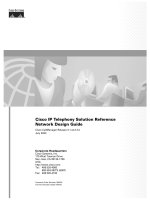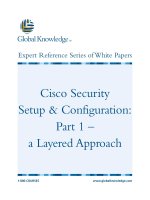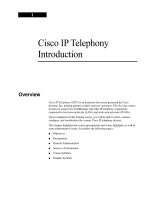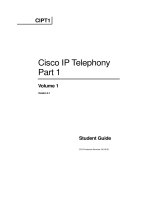Tài liệu Cisco IP Telephony- Enterprise Voice Over Data Design Test pdf
Bạn đang xem bản rút gọn của tài liệu. Xem và tải ngay bản đầy đủ của tài liệu tại đây (317.07 KB, 11 trang )
Cisco Design Essentials: Cisco IP TelephonyEnterprise Voice Over Data Design Test
1)
Which of the following statements are true of CallManager 2.4 multi-site WAN-distributed call processing?
a. A CallManager and MTP is required at each location
b. A Cisco IOS gatekeeper is required for admission control
c. A minimum of Cisco IOS gateway of IOS 12.0(6)T is required
d. G.711 only for all IP WAN voice calls
e. All of the above
f. B and D only
2) In ATM while a typical voice payload takes only 20 bytes of a 48-byte payload resulting in 28 bytes of padding,
efficiency is gained because the predictable fixed-length cells allow highly efficient switching that can be built into
chip design.
a. True
b. False
3) ____________________ is a technique for breaking up and re-assembling large data frames to avoid "freeze-out"
of delay-sensitive traffic in the network.
a. Traffic shaping
b. Committed access rate (CAR)
c. Fragmentation and interleaving
d. RSVP
4)
Which of these statements are true about the IP WAN with centralized call processing using CallManager 2.4?
a. All local gateway access codes must be different
b. Conferencing and voice mail must use G.711
c. Phones are out of service if the WAN goes down unless there is dial backup
d. All the above
e. A and B only
5) Consider this scenario. You want to connect your IP Telephony network to the central office switch using E1 (or
T1 PRI). Which of the following choices is an appropriate gateway selection?
a. the DT-24+ (or DE-30+) IP Telephony gateway
b. AS5300 Cisco IOS Gateway using 12.05(T)
c. MC3810 Cisco IOS Gateway using 12.05(T)
d. A, B, and C
e. A and B
f. B and C
g. A and C
6)
Which of the following statements are true about Voice over Frame Relay services?
a. Primary payload types may inc lude voice, fax, or data
b. Signaled payload types may include dialed digits, silence information, or CAS ABCD bits
c. Management payload types include faults and performance measurements
d. A and B
e. B and C
f. A and C
g. A, B and C
7) Low-speed links require link fragmentation and interleaving at Layer 2 (similar to MLPPP or FRF.12) for circuits
running slower than 768 kbps. Which of the following is a valid workaround?
a. Use two PVCs, one for voice and one for data
b. IP MTU reduction
c. Either, with caveat
d. Neither, in any case
8)
Which of the following are you least likely to encounter providing PBX trunk signaling?
a. ISDN PRI D channel
b. DASS#2
c. FXS loop start
d. a proprietary PBX-to-PBX protocol such as Lucent's DCS+
9) You are looking at a Voice over Data design for a customer who wants to replace voice trunk lines in a private
voice network. Which of the following considerations are important as part of the Voice Network Assessment?
a. The location of the PBXs and what protocols are run on the PBX trunks
b. Which PBX services must be preserved
c. Determining whether existing voice mail is centralized or distributed
d. A, B, and C
e. A and B
f. B and C
g. A and C
10)
A design recommendation for IP addressing of IP Phones is to:
a. Use Dynamic Host Configuration Protocol (DHCP)
b. Blow holes in you firewall if you need to cross NAT boundaries
c. Use static addressing
11)
Which of the following is a variable source of delay in voice networks:
a. Queuing delay
b. Propagation delay
c. Serialization delay
d. Coder processing delay
12) If a CallManager is located remotely from the uOne application server and message store, transfer time for
downloading a message over the WAN can create a problem since the entire message must be retrieved before it is
played back.
a. True
b. False
13)
_______________ provide a "clear channel" where the entire payload can be filled with one voice channel, or a
continuous stream of bytes can be placed into cells.
a. T1/E1 unstructured services
b. T1/E1 structured services
14)
Which of the following is not included in the H.323 protocol?
a. Quality of service (QoS)
b. Voice coding
c. Video coding
d. Signaling
15) Loop start signaling may be associated with either the station side or the Central Office side of PBX interfaces.
a. True
b. False
16) Calculate the approximate bandwidth for G.729 payload using a 20-ms voice sample that generates a 50-pps
stream. Assume a 7-byte header. The effective bandwidth required per call is approximately:
a. 8.0 kbps
b. 10.8 kbps
c. 32.0 kbps
d. 67.0 kbps
17)
You are designing an IP Telephony solution. Which of the following voice mail considerations are important?
a. Is the legacy voice mail system preserved?
b. Do I have SMDI support on the legacy voice mail system?
c. If using uOne, is the uOne server colocated with the CallManager?
d. A, B, and C
e. A and B
f. B and C
g. A and C
18)
How many bytes of padding would be in the payload of an ATM AAL5 cell containing 20 ms of G.729 voice?
a. 20
b. 28
c. 44
d. 48
19)
The mechanism used to prevent selected phone extensions from calling long distance is:
a. Class of service (CoS)
b. Coordinated dialing Plan (CDP)
c. Automatic Route Selection (ARS)
d. Basic Route Selection (BARS)
20)
If a legacy voice mail system has an SMDI interface, CallManager can connect to it as a virtual PBX.
a. True
b. False
21) Consider this scenario. You have two branch offices using IP telephony with CallManager 2.4. To handle
admissions control between the two offices over a WAN, which of the following solutions will work?
•
•
Solution A: Use a central CallManager (perhaps redundant CallManagers) with each office being a separate
region. Intra-region calls can be G.711, but inter-region calls can be G.729 (unless to voice mail). Limit WAN
bandwidth at each egress point and block calls that will exceed that level.
Solution B: Put a CallManager in each location and network them together using H.323 (running on a Cisco
IOS gatekeeper). You can then use the zone bandwidth feature to limit the number of calls and force overflow
to the Public Switched Telephone Network (PSTN).
a. Solution A
b. Solution B
c. Either A or B
d. Neither A nor B
22)
VAD is a mechanism for reducing bandwidth requirements when transporting:
a. Voice over IP
b. Voice over Frame Relay
c. Voice over ATM
d. A, B, and C
e. A and B
f. B and C
g. A and C
23)
The manual attendant console for CallManager is a Web-based software console.
a. True
b. False
24)
Which of the following statements is not a characteristic of FRF.11?
a. It provides application support for compressed voice
b. It provides multiplexing of up to 255 subchannels
c. It allows multiple payloads
d. It uses a predictable fixed length payload
25)
Which statement about voice activity detection (VAD) is NOT true?
a. VAD can be turned on or off as a configuration option
b. VAD is attractive because of bandwidth efficiency
c. VAD requires a 5 ms look-ahead buffer
d. VAD may cause noticeable clipping at the beginning of speech after a silence period
e. VAD adapts to Music on Hold, thus continuing to reduce voice bandwidth
f. All of the above
g. None of the above
26) Cisco-switched VoFR protocol includes forwarding of the called telephone number and supports tandem
switching of the call over multiple Frame Relay permanent virtual circuit (PVC) hops.
a. True
b. False
27)
Voice mail applications:
a. Are critical to the enterprise
b. Are proprietary in legacy systems
c. Have to be replaced by uOne in the Architecture for Voice, Video and Integrated Data
(AVVID) IP Telephony solution
d. A and B
e. B and C
f. A and C
28) This coding algorithm produces a digital signal with a reduced bit rate by recording only the difference between
samples; it is used mostly in traditional telephony.
a. PCM
b. ADPCM
c. CS-ACELP
d. LDCELP
29) In traffic shaping, when shaping to a lower-speed link and the ratio of the line rate to the CIR is high (for
example, a T1 shaped to 64 kbps), you need to set the committed burst (Bc):
a. Higher
b. Lower
c. It doesn't make any difference.
30) Cisco's uOne is a standards-based messaging application that manages message playback, message delivery, and
the message creation process in CallManager 2.4 deployments.
a. True
b. False
31) Real-time Transport Protocol (RTP) is an industry standard for transporting:
a. Voice over IP
b. Voice over Frame Relay
c. Voice over ATM
d. A, B, and C
e. A and B
f. B and C
g. A and C
32)
This IP Telephony component provides functions like call setup and teardown and dial plan implementation.
a. CallManager
b. Media Termination Point (MTP)
c. uOne
d. IP Phone
e. Gateway
33)
Frame Relay and ATM interworking are provided through:
a. FRF.5
b. FRF.8
c. FRF.12
d. A, B, and C
e. A and B
f. B and C
g. A and C
34)
The CallManager database uses _________ to tie an actual IP Phone to a telephone number.
a. Media Access Control (MAC) address
b. Directory Number
c. Line Appearance Number
d. IP Address
35) Bandwidth calculations assume one party speaks at a time; therefore, if both speak at the same time, the
bandwidth requirement doubles.
a. True
b. False
36)
Because of FRF.12, you never have to use IP MTU reduction over a Frame Relay network.
a. True
b. False
37)
Lucent's DCS protocol provides ____ voice channels on a T1.
a. 21
b. 22
c. 23
d. 24
38) CallManager 3.0 will support transcoding. This allows call legs with different encodings (for example, G.711
and G.729a) instead of the current requirement that a call have the same encoding from end to end.
a. True
b. False
39) If a gatekeeper is used to set up a call, once the call is established the voice path also traverses the same
gatekeeper.
a. True
b. False
40)
This IP Telephony component translates calls between the IP Telephony environment and the PSTN.
a. CallManager
b. MTP
c. uOne
d. IP Phone
e. Gateway
41)
Which of the following are limitations encountered in deploying CallManager2.x?
a. No QSIG support.
b. Message Waiting Indicator is lost for legacy voice mail systems
c. Calling party ID is lost between CallManager and legacy PBX
d. A and B
e. B and C
f. A and C
42) H.225 registration, admission, and status (RAS) channels are unreliable and subject to timeouts and retry
counts.
a. True
b. False
43)
Which of the following statements are true about echo cancellation?
a. Echo is due to the way handsets are wired
b. Echo cancellation at your end prevents echo being heard at the far end
c. The echo canceler runs in Cisco IOS
d. A, B, and C
e. A and B
f. B and C
g. A and C
44) Consider this scenario. You are planning a Voice over Data network design and you determine that the
customer's existing WAN data infrastructure is Frame Relay. What impact, if any, does this have on your design?
a. Requires the use of Frame Relay as the voice transport protocol (Voice over Frame Relay)
b. Determines when the voice busy hour will be
c. Determines bandwidth requirements for carrying voice calls over the existing data network
d. A, B, and C
e. A and B
f. B and C
45) In implementing Voice over Data networks, in all likelihood you will be able to use the legacy dial plan without
any changes.
a. True
b. False
46) Cisco gear can perform tandem PBX bypass in the router, avoiding multiple voice encodings and avoiding the
use of valuable PBX trunks.
a. True
b. False
47)
Which of the following is a fixed source of delay in voice networks:
a. Queuing delay
b. Dejitter buffers
c. Coder processing delay
d. Variable packet sizes
48) CallManager 3.0 will support MGCP, which allows for Cisco IOS gateway and CallManager integration
without an MTP.
a. True
b. False
49)
Which transport technique is preferred to carry Lucent's CMS?
a. Digital cross connect
b. Frame forwarding
c. D-channel ATM CES
d. STUN
50)
Which of the following is a proprietary Nortel PBX protocol?
a. DCS
b. DPNSS
c. MCDN
d. CORNET
Grade









